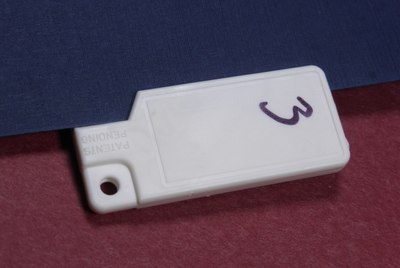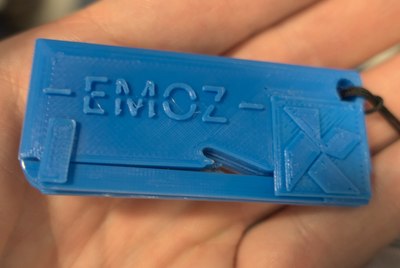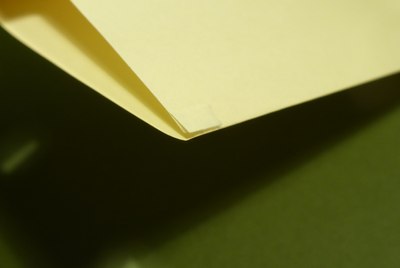Envelopener usage and maintenance
Envelope openers are very useful tools for origami folders and other craftspeople, but they do have a number of quirks. After answering a question about getting a clean cut with an Envelopener on Arts & Crafts Stack Exchange, I decided to write this text. It describes some techniques I found useful for avoiding split corners and other mishaps while cutting paper with envelopeners.
How they work
An Envelopener is a tool which makes it possible to cut paper very cleanly, with sharp, well-defined edges almost indiscernible from the factory-cut edges. These cuts are much better than can be made with a knife or scissors. This is very useful if you work with large paper sheets which need to be cut down to size, as is the case with most complex origami models and tessellations.

The tool, shown in the first picture, consists of a plastic casing inside which a very sharp and specially shaped blade is hidden. The case guides paper along the cutting edge and at the same time protects the user from cutting themselves.
In order to make a cut, you crease the paper, forming a V-shaped valley fold, insert the end of the crease into the envelopener, and pull it along the crease. The razor-sharp blade inside cuts the paper while the case guides the edges into proper position.
Historic note: the white cutter in the first picture is the classic envelopener, which was produced by a single company in the Netherlands, who patented the design. At one point, production stopped, and envelopeners became much harder to come by, and more expensive. Some people created for their own use makeshift paper cutters from cardboard and safety razor blades.

Fortunately, after a while, it became possible to design more professional papercutters, different enough from the original envelopener to not be protected by patents, and to produce them via 3D printing. These models are (as of 2020) a bit more bulky than the original, but their advantage lies in the ability of the design to be modified, e.g. by adding a logo or by giving the cutter a custom shape. You can see an example (with the logo of EMOZ origami museum) in the image presented here.
What they are good at
The usage method described above means that envelopeners work best with long straight cuts and when the cut is perpendicular to the paper’s edge. This is typically the case when cutting a square for origami from a rectangular sheet or splitting a piece of paper into smaller pieces.
What they are bad at
Conversely, an envelopener may not be the best tool for cutting if:
- you only need to make a short cut
- you need to cut along a curved line
- the cut is not perpendicular to the edge (e.g. when cutting hexagons rather than squares)
Common problems
When you use your envelope opener, you will get a nice clean cut most of the time, but not always. Typical issues include split corners, the blade making no cut at all, and paper getting stuck in the blade.

A split corner (shown in the image) is when the blade, instead of going in between the two folded halves of the paper and separating them, cuts parallel to the paper, plying it and separating some layers. This results in no cut along the planned line and an ugly hanging piece of paper which may easily tear off.
Another popular mishap is when the blade doesn’t grasp the paper at all and just clears it without making any cut. This is frustrating but at least it leaves no mark on the paper.
The paper may also get stuck in the blade, not allowing you to slide the envelopener forward without risking a tear. If this does happen, it is best to not force it, but back off, pull the blade back along the path it came, and start again from the other end of the crease.
Getting a clean cut
Here are some tips and tricks which I have found useful for avoiding split corners and getting nice, clean cuts instead.
Envelopener care and maintenance
- Envelopeners are consumables: they will become blunt over time and there’s not much you can do about it. Since they are cheap, simply replace them once in a while, especially if you start running into issues more often than you used to. Your mileage may vary depending on how often and what types of paper you cut, but mine last less than half a year. Since I always keep several, I number them (this is where the number 3 in the image comes from), and this way I know that if I’m currently using number 3 for day-to-day work, number 4 is going to be the almost-new one which I can start using once number 3 gets blunt or if I have a special piece of paper where I want to minimize any risk of a bad cut.
- The blade which sits inside the tool is pressed between two halves of the plastic case. You can open the case by inserting a fingernail or a screwdriver blade
into the narrow gap between the two halves. This will allow you to:
- Clean the blade from paper residue which gathers around it. Some envelopeners have a shaft which is supposed to allow the lint to escape from the blade but this does not always work perfectly.
- When closing the case, press the two pieces of the case firmly together. Sometimes the two halves become a little loose, causing the blade to not be mounted in a fully symmetric manner, which can cause both parts of the paper to move around a single side of blade instead of getting the blade exactly in between them.
Cutting technique
- The envelope opener works best if the crease along which you cut is perpendicular to the paper edge. So, it’s good for cutting squares but much worse for
cutting hexagons. I use a Swiss Army knife or scissors for cutting hexagons since the envelopener doesn’t handle them well.
- However, there is a trick which helps (somewhat) to make a cut at an angle different than 90° (eg. for cutting a hexagon): you can insert a small rectangle between the two layers of the fodled sheet which you want to cut. This will provide an artificial right angle for the cutter to grab the paper and allow a much better cut than when you try to cut at an angle directly.
- Split corners are more likely when you try to cut thick paper and the crease along which you cut is pressed too firmly (e.g. using a bone folder). Sometimes it helps to either not make the crease that sharp, or to fold it in the reverse direction after folding, which also results in a somewhat less sharp fold. Additionally, I sometimes open the initial part of the V-shaped crease and flatten the bottom a little with my fingers.
- As mentioned above, an envelope opener consists of two plastics casing parts with the blade fixed in the middle right between them. These two halves of the case do not always perfectly fit together and there may be a small gap between them. Sometimes when you start cutting, you may press the paper too deep inside the casing, which causes the creased part of the paper to get stuck in this narrow gap. The solution is to check that you are not inserting the paper too deep.
- If you do split a corner, better start the next cutting attempt from the other end of the crease.
- Likewise, if your blade gets stuck and you have to pull it out of the crease, start the next attempt from the other end of the crease. Getting the blade into an existing cut is very hard.
While these tips do not guarantee a 100% success rate, and I still occasionally do make a bad cut, I think that I have become better at using the envelopener over time, so I hope they are helpful for others as well.
Comments